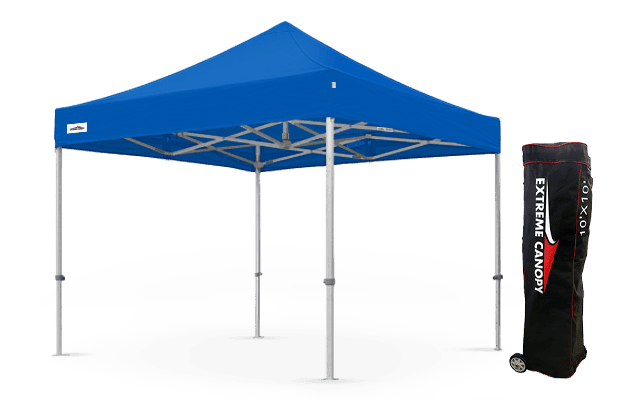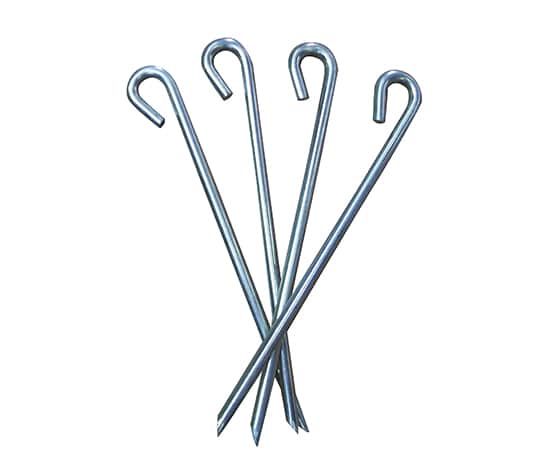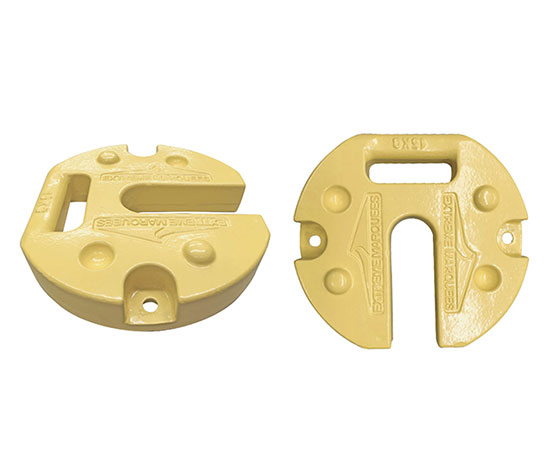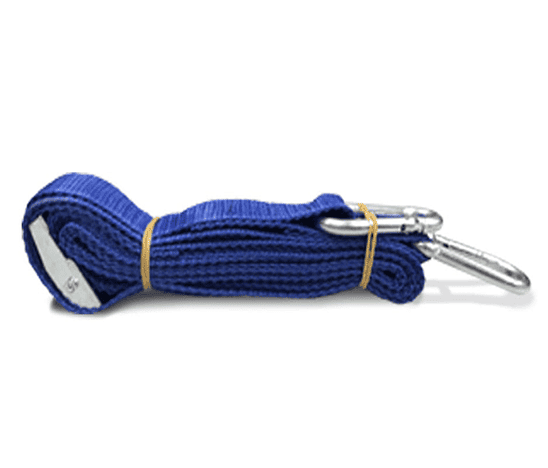How To Secure Your Canopy Tent in Any Setting
canopy tent is a great way to provide shelter on the go. That being said, canopy tents aren’t impenetrable fortresses. Wind, rain, and slanted terrain can all pose structural issues for these temporary shelter solutions. However, with proper setup protocol, extra securing measures, and a bit of added weight, most canopy tents can be made to withstand the majority of inclement weather scares. In this guide, our expert tent manufacturers here at Extreme Canopy will show you to how properly secure your instant canopy tent in any setting. Follow our professional guidance to ensure that your canopy tent stands strong no matter what the weather has in store, and shop industry-leading canopy tents and canopy tent accessories from our team today!
Start With Proper Setup of Canopy Tent
No canopy tent can be adequately secured without first being set up properly. Improper set up can lead to a number of structural and safety concerns, so it’s best to learn exactly how your tent is supposed to be set up before moving on the following tent-securing suggestions. Thankfully, setting up an instant canopy tent is quite simple. Most canopy tents feature a no-assembly-required design: they come with pre-built frames that simply need to be expanded to stand up on their own. When setting up your canopy tent, start by opening the carrying case and expanding the frame from each of the four legs just a little. (It’s best to have four people help out during this phase — one for each leg.) After you’ve partially expanded your tent’s frame, make sure that each of the height-adjustable legs is set to the same height. (Make sure each leg clicks on its height setting.) It’s also a good idea to make sure your tent’s fabric roof is properly attached during this phase.
Once you’ve completed these steps, gradually expand your canopy tent to its full size. Attach any sides or tent accessories once your tent is fully expanded in its final location. As a final step, be sure to double-check any tie-downs or Velcro fasteners to ensure a secure hold. Often, negligence during the set-up phase is the culprit behind tent difficulties, so be sure to closely follow each and every step of the set-up process to save yourself headache later on.
Be Mindful of Your Terrain
Even with proper set up, a canopy tent may not stand depending on the conditions. For instance, a canopy tent that’s set up “properly” on uneven terrain is destined to topple. Likewise, canopy tents erected on soggy ground may sustain damage or fall over altogether. When setting up your canopy tent, be mindful of the terrain around you. Choose a location with even ground. Areas with short grass and semi-firm soil are best for staking. If concrete or asphalt is all that’s available, make sure to set up your tent clear of any large cracks or potholes. Beware of water and stay away from any nearby trees or bushes, as these can both rip the fabric of canopy tents and topple them altogether should a sufficiently strong breeze roll in. Overall, when erecting your canopy tent, follow the golden rule of real estate: location, location, location. A smart location will go a long way in ensuring structural security.
Use Sturdy Canopy Tent Stakes – Steel is an Excellent Choice
In many situations, tent stakes are the primary source of tent security and stability. Typically made of metal materials and measuring roughly six inches to a foot in length, tent stakes are designed to fasten to the base of a tent and stick into the ground to provide extra hold. Most canopy tent have stake holes on each of their legs. While many tents come with stakes, it’s always a good idea to invest in an extra set (or two) so you’re always prepared. When choosing your tent stakes, be sure to pick the strongest material possible. Stakes made of plastic or low-grade metals are much more likely to bend, break, or be pulled from the ground in the event of force. Choose stakes made of steel for greater durability and a stronger hold. Also, be sure that your stakes are shaped properly to grab onto your tent’s legs while sticking into the ground. Stakes that are simply straight without any kind of head can detach from tent legs rather easily. Invest in stakes that feature hooks or loops on their end to ensure excellent hold. Here at Extreme Canopy, we sell canopy tent stakes made of steel and shaped with a hooked head for great grip and a sustained hold under stress. Hammer them all the way into the ground for best results.
Setting Up on Concrete or Asphalt? Use Tent Weights!
Sometimes, canopy tents must be set up on hard ground such as concrete or asphalt. In these situations, stakes simply won’t work. However, tents must still be grounded to avoid blowing over in the wind or getting knocked over by crowds. The solution is weight. If you are setting up your tent in a parking lot or on a concrete walkway, attach tent weights to each of the legs of your tent to help prevent it from swaying, sliding, or blowing over altogether. For this purpose, durable and adequately-weighted sandbags are an excellent choice. At Extreme Canopy, we sell specially-made instant canopy sandbags made from durable synthetic fabric and equipped with strong Velcro straps for lasting attachment to canopy legs.
If you find that the sandbags around your canopy tent’s legs aren’t adding enough weight, there is another trick you can try to further secure your structure. Fill a 5-gallon bucket with sand and tie it to the crossbar of your canopy’s frame with rope or EZ strapping. Make sure the bucket is fully grounded and not hanging, and try to use at least two buckets — each on opposite sides — to balance weight evenly. (A bucket for each crossbar — four in total — is ideal, though not necessary.)
Add Anchors for Extra Reinforcement
After stabilizing your tent with stakes or weights, you may find that you need even more stabilization for your current setup. Areas with excessive winds or particularly rowdy crowds can pose serious structural risks for canopy tents, so if you’re thinking you’d rather be safe than sorry, you’re thinking the right way. To add extra stabilization to your canopy tent after staking it in or weighing it down, consider adding tent anchors for extra reinforcement. Tent anchors are durable straps fastened to a tent’s frame and attached to a stabilizing object near the tent. Often, tent anchors are anchored to extra stakes placed several feet from the tent’s frame. Sometimes, they’re tied around weighted barrels or clipped with carabiners to a nearby building. If you choose to use tent anchors, make sure to fasten them to strategic points on your tent’s frame so they do not pull your tent in any one direction. The goal is to create balanced tension to supplement your stakes or weights. Here at Extreme Canopy, we carry heavy-duty tie down ropes designed to anchor canopy tents to stakes or other nearby structures.
What About Water Damage? These Canopy Tent Accessories Can Help!
Thus far, we’ve discussed ways to keep canopy tents stable against outside forces such as wind and crowds. These forces are the most common culprits when it comes to knocking tents over, but they’re not the only things that pose structural concerns for canopy tents. Another common culprit is water. Whether from rain, snow, or soggy ground, water can seep into a canopy tent and cause major structural damage and health risks over time. For one, water can rust tent frames made from low-grade metals. We recommend investing in aluminum or coated steel frames to prevent rust. Water can also lead to mold in fabric roofs and sides, rendering them both useless and dangerous. We recommend investing in water-resistant vinyl roofs and sides to stay protected from mold no matter where you use your canopy tent.
Even with the right materials, water can still damage canopy tents is conditions are sufficiently poor. If you anticipate heavy moisture and precipitation in your tent’s future, it is a good idea to invest in tent accessories designed to mitigate water damage. These include extra sides, rain gutters, and tent flooring. Also, tent carrying cases are essential for safely transporting tents during inclement weather. If rain is forecasted in your tent’s future, consider investing in these accessories to help your tent stay dry and free of damage.
Always Choose Quality
The final recommendation in our guide is one that applies to all of the above steps and products. It’s a simple suggestion, and it should never be ignored. Always, and we mean always, choose quality when it comes to your canopy tent. Starting with your tent itself, invest in a well-reviewed product made with high-quality materials such as aluminum or coated-steel frames and weather-resistant vinyl fabrics. Choose a custom canopy to ensure that size and appearance are made exactly to your specifications. Make sure your tent accessories are made from heavy-duty materials, as this will ensure that they do their jobs without fail. Lastly, ensure that the people helping you set up your instant canopy tent know what they’re doing. This will help prevent complications from the get-go.
Get More Canopy Tent Setup Tips and Shop Industry Leading Branded Tents at Extreme Canopy
With the above suggestions, you should be ready to securely set up your canopy tent in any setting. If you have additional questions or would simply like to learn more about canopy tents, contact our experts here at Extreme Canopy to speak with a member of our team directly. We’ll be happy to provide you with professional advice and information regarding canopy tents and custom tent usage. Ready to order your very own custom canopy tent? Shop our inventory of industry-leading instant canopies, pinnacle marquees, and pavilion tents to find the perfect custom canopy for your needs, and order online directly from our trusted manufacturers today!






